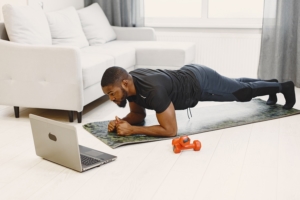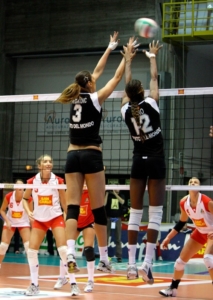 The global COVID-19 pandemic has been devastating for gyms, which were one of the first businesses to shut their doors amid lockdown regulations.
The global COVID-19 pandemic has been devastating for gyms, which were one of the first businesses to shut their doors amid lockdown regulations.
“But the pandemic has also driven positive trends around exercise as more people are now aware of the importance of health and fitness,” explains Paul Mills, Managing Director at the Health & Fitness Professionals Academy (HFPA).
As a consequence, more people are looking to start and maintain exercise programmes. This new paradigm has created an interesting situation for fitness professionals, especially as many gyms and training facilities have struggled to survive due to the lockdown’s economic impact on their business.
With less physical capacity to train clients in person, growing financial constraints among consumers, and a hesitance by many members to rush back to gym due to concerns regarding infection risks, personal trainers need to embrace an augmented model to maintain their relevance and sustain their business.
The COVID catalyst
The transition to online training and coaching was already on the rise before the pandemic altered the way we live and exercise. Adapting to the lockdown has merely accelerated the shift to the digital engagement model as the COVID-19-related lockdown forced gyms, studios and fit pros to pivot to an online service delivery model.
“The lockdown was really challenging for fitness professionals. With no physical space, everyone needed to become digitally savvy overnight and shift their offering online to sustain their business and generate an income,” continues Mills.
The COVID-19 Fitness Industry Impact Report, compiled by Fitness Australia, showed that 81% of exercise professionals and industry players lost their job or main source of income due to gym closures and social distancing restrictions.
However, the survey findings, which are based on responses from 1,177 exercise professionals and sole traders, and 282 boutique and multi-service facility gyms, found that just under half of respondents were able to generate new sources of income by moving online or adopting one-on-one outdoor PT sessions.
The online pivot

This pivot to digital engagement took many forms, as personal trainers and fitness instructors found themselves at varying points on their digital transformation journeys.
“While some had embraced bespoke or white-label apps before the pandemic, the majority simply leveraged video conferencing platforms to keep booked sessions with clients through the lockdown.”
A survey of over 700 Mindbody app users affirmed that wellness routines during and post COVID-19 lockdowns changed in a positive way, with respondents reporting that they worked out more while at home, rather than less.
Specifically, a mere 7% of app users live streamed workouts in 2019, but that increased to over 80% during the COVID-19 pandemic. In April, 85% of survey respondents reported live streaming a workout on a weekly basis, with yoga and HIIT-style workouts like Tabatas or bootcamps the most popular modalities.
A New Workout culture
But now that gyms have reopened, Mills expects members to make a gradual return to training in brick-and-mortar facilities.
“People will return to gym, there is no doubt about that. The gregarious nature of people means that the more we work online and remain isolated from others, the more we want human contact. As such, people will return to gyms when they feel ready. And gyms across the globe have also seen an increase in new members as people prioritise their health.”
However, fit pros should maintain their online focus with a mixed business model because it is unlikely that gyms will see an immediate return to the attendance figures experienced before the pandemic. For instance, 43% of respondents in the Mindbody app survey expect to blend their previous routines and virtual content or live streaming, even when the pandemic is over.
“It has become clear that contemporary fitness professionals will require an augmented model going forward, offering some in-person and some online instruction,” elaborates Mills. That means fitness professionals will need to adapt their offering to meet the demand for contactless or low-touch physical workout experiences, while delivering convenience and affordable online training options in response to the financial crunch clients are experiencing.
Potential benefits
But rather than posing a threat to their business, this shift represents a massive opportunity for fitness professionals moving forward. According to Mills, the move to digital proved that clients are willing to pay for virtual workouts, and the digital marketplace opens up significant opportunities for fitness pros to reach a global marketplace, which broadens their potential customer base, and allows them to bill in a foreign currency.
“Trainers can also use online sessions to reach clients at times when gyms are traditionally quiet, which effectively increases their billable hours,” he explains. However, trainers will need to create innovative programmes that leverage what clients have at their disposal at home. “But this also creates opportunities to start selling at-home workout equipment and up-sell programmes as clients advance,” adds Mills. In this context, the aftermath of the pandemic offers a significant opportunity for fitness business growth.
Making the switch
“To succeed in this market, personal trainers and instructors need to understand the need for auxiliary online services and support, and determine how to effectively use both models,” explains Mills.
In this regard, Mills suggests that fit pros reconsider their offering to include options that target individuals and groups, with structured packages for clients that augment physical and online sessions and offer variable pricing. “It is vital to develop a business plan that covers every facet of this model and clearly defines the services a trainer will offer online versus in the gym. Spotting a gap and finding a niche will also determine a fit pro’s success given that industry professionals are transitioning to this model en mass.”
Consider the threats
Fit pros should also remain cognisant of the potential threats posed by this switch to digital as it opens up the industry to greater competition. “The digital marketplace lowers the barrier to entry, while the abundance of standardised ‘cookie cutter’ programmes can dilute a fit pro’s offering. As such, trainers who engage via low-touch digital channels will need to market and sell the importance of individualised programming and constantly add value by tracking progress and adapting programmes based on regular testing to ensure their clients continue making progress,” asserts Mills.
Furthermore, anyone with some understanding of fitness and training can also commercialise their experience via digital channels, even if they don’t have a valid qualification. The lack of regulation for online service providers, coupled with access to international fitness celebs and personalities, makes education and qualifications more important than ever.
Qualifications matter
“In this context, qualifications will remain the foundation on which fitness professionals build successful businesses. Expertise, experience and client success will differentiate fit pros from the rest in the increasingly cluttered online marketplace,” states Mills. HFPA has catered to this need amid the pandemic by adapting their teaching approach to embrace a hybrid model.

“We’ve also updated our course material to effectively blend face-to-face and distance learning,” explains Mills. “We invested in expensive video equipment and white screens to deliver engaging and relevant content online, which students have enjoyed. This also means students who want to stay at home haven’t had to rush back, and that we can accommodate smaller classes.”
For returning contact students, HFPA continues to run its curriculum using the high-touch model to provide engagement with tutors. “This includes running live practicals with students nationally, adhering to COVID protocols.” Mills believes that students have learnt important lessons from this model because it demonstrates what is possible and helps them understand the value of offering options to clients.
The soft skills
Additional considerations when setting up a digital offering include selecting the best digital platform and engagement methods based on client preferences.
“There are so many platforms out there, which all come with different packages and cost structures. Functionality and content also differ, which means there is no one-size-fits-all solution,” says Mills. More importantly, fit pros must ensure that they can still fulfil one of their most important roles – offering clients support and motivation – when engaging online.
“Much of what a trainer does is about motivation. They must find ways to be there to encourage and maintain client accountability, even if they’re not physically present at a session during the week,” adds Mills.
In this regard, Mills says there are various ways to hold clients accountable, be it instant messaging, tracking uploaded workouts via an app, or encouraging clients during live virtual sessions. “No matter what platform the trainer uses, they must still come across in a professional manner and deliver an engaging and effective session.”
The bottom line
According to Mills, operating in this new normal is all about agility and adaptability. “Success will hinge on a fit pro’s ability to provide their product or service in the way clients want, across multiple environments.”
So, for those trainers who have patiently bided their time, waiting for gyms to reopen, Mills suggests that it’s time to craft a comprehensive offering and build an online profile.





 Tell us a little bit about yourself and what you do.
Tell us a little bit about yourself and what you do.